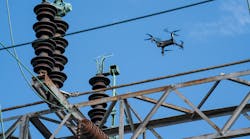Progress toward a more reliable and efficient national power grid has begun at the University of Arkansas as construction started on the College of Engineering's National Center for Reliable Electric Power Transmission. When finished, the 7000-square-foot, state-of-the-art facility, under construction at the Arkansas Research and Technology Park in south Fayetteville, will have 6.5 MW power capacity for testing components rated up to 15 kV and will be the only facility of its kind in the United States.
"We are extremely excited to be filling a need for Arkansas and the nation with regard to education and research on the modernization of the electric power grid," said Alan Mantooth, UA professor of electrical engineering and the center's director. "This facility will be the hub of advanced power-electronics research and education in mid-America and will help address the growing shortage of engineers in this field over the next decade."
The center will house equipment and researchers, including faculty and graduate students, who will design, test and package purely electronic systems for future commercial use in the nation's power grid. In the future, solid-state equipment, made partially of silicon-carbide, will replace outdated and obsolete electromechanical devices. The new equipment will improve response time and increase reliability of the grid, as well as help localize outages, which did not happen in the 2003 blackout in the Northeast United States, the largest and most catastrophic power failure in U.S. history.
Mantooth conceived the idea for the center after the 2003 blackout. He knew that the university had a critical concentration of researchers who for many years had investigated silicon-carbide, a semiconducting material that is more durable and faster than materials currently used in the power grid. In 2005, Mantooth and a team of electrical-engineering researchers received a $1 million congressional appropriation, administered by the U.S. Department of Energy's GridWorks Initiative, to create and operate the national center.
Mantooth said the UA team was chosen because of the researchers' expertise in advanced power electronics and their longtime investigation of silicon-carbide. For the past decade, UA electrical engineers have developed and packaged silicon-carbide systems for the National Aeronautics and Space Administration and the defense industry. The UA team was one of the first to investigate the material's application to power technology.
Silicon-carbide is a superior material for several reasons other than its strength and ability to respond quickly to power interruptions, Mantooth said. Its properties allow an extremely high voltage capability. It is also a good thermal conductor, which means it can operate at high temperatures and does not require extra equipment to remove heat. This property can reduce overall mass and volume on a power grid.
The center's researchers will create mathematical models of silicon-carbide devices to simulate the design of large systems. Those devices will then be rigorously tested and packaged. Packaging involves creating protective coatings and enclosures to prevent the material from breaking down when subjected to high voltages and currents and when interacting with air and water.
Funding for the new national center is part of the federal government's focus on research and development to improve technology on the nation's power grid. In response to the massive blackout of the Northeast United States in 2003, Congress passed the Energy Policy Act of 2003, which created the GridWorks Initiative.
Mantooth expects to receive an additional $2.5 million from the Department of Energy in 2007. He estimates the center will need approximately $6.5 million over the next three to five years to reach full research and testing capacity.
Mantooth said the 2003 blackout, which affected about 50 million people and caused billions of dollars in lost revenues, should have been limited to a local area. Research at the UA center will help to localize transient surges and prevent rolling blackouts.
Even with the existing electromechanical switches functioning properly, the entire process is too slow to offer the needed protection in some cases, Mantooth said. Solid-state systems made of silicon-carbide could lead to purely electronic switches that would react as much as 200 times faster than the electromechanical switches that are currently present in the power grid.
In addition to his position as professor, Mantooth was recently appointed to the Twenty-First Century Chair in Mixed-Signal Integrated Circuit Design and Computer-Aided Design in the College of Engineering.

